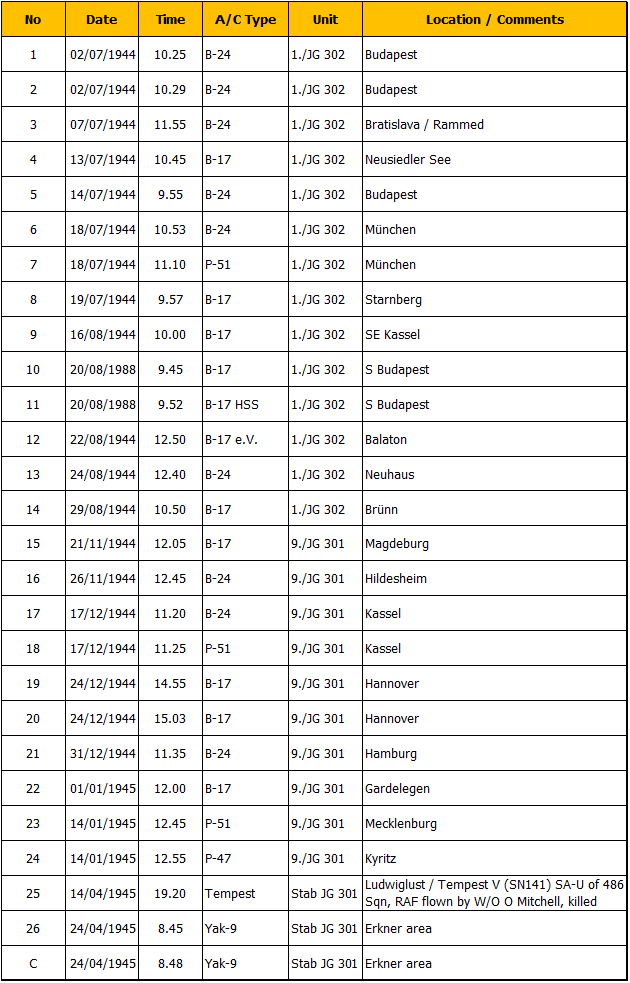Il pilota Willi Reschke - Myouth - Ricordi degli anni '70
Menu principale:
Il pilota Willi Reschke
Modellismo > Aerei > Focke Wulf TA 152 H
Il pilota dell'aereo del modello è l'Oberfeldwebel (Maresciallo) Willi Reschke
The pilot of this airplane was Oberfeldwebel Willi Reschke
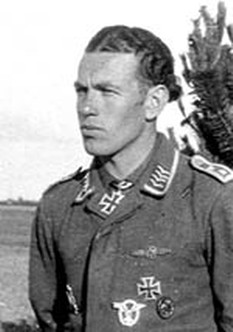
Willi Reschke
Willi Reschke (3 February 1922 – 5 July 2017) was a Luftwaffe ace and recipient of the Knight's Cross of the Iron Cross during World War II, credited with 27 aerial victories in 70 missions. In 1999, Reschke recounted his wartime experiences in print, published in English in 2005 as "Jagdgeschwader 301/302 'Wilde Sau': In Defense Of The Reich with the Bf 109, Fw 190 and Ta 152;" including writing about the late-war period he spent flying the exotic Focke-Wulf Ta 152 high-altitude fighter-interceptor designed by Kurt Tank.
Early life and career
Reschke was born on 3 February 1922 at Mühlow, Province of Brandenburg, present-day Miłów in western Poland. Mühlow is located approximately 15 kilometres (9.3 miles) northeast of Guben where the Luftwaffe operated an A/B flight school. According to his own account, there Reschke developed his interest to become an aviator. In February 1940, he volunteered for military service in the Luftwaffe. His medical checkup was conducted at Paunsdorf, a borough of Leipzig, and was accepted. One year later, on 4 February 1941, he joined the Fliegerausbildungs-Bataillon at Königsberg in der Neumark where he received his basic training.
Reschke commenced pilot-training in spring 1942. On 6 April 1943, flight training continued at Neiße, present-day Nysa, Poland. There he learned to fly the Klemm Kl 25, Arado Ar 66, Focke-Wulf Fw 56 and Arado Ar 96 with a focus on formation flying, cross-country flying and aerobatics. Additionally, he also took classroom courses in navigation. Reschke completed flight training on 27 June 1943 and he was presented with theAviator badge (Flugzeugführerabzeichen). On 23 October 1943, Reschke served with Jagdgeschwader 102 (JG 102—102nd Fighter Wing), formerly Jagdfliegerschule 2 (2nd fighter pilot school), in Zerbst to undergo operational training. On 13 June 1944, Reschke continued his training at the Ergänzungs-Jagdgruppe West, a supplementary training unit for fighter pilots destined to fight on the Western Front which was based in Gabbert, present-day Jaworze in northwestern Poland. Over the next three days, he made 21 combat simulation flights. On 18 June, he was sent to a front-line fighter unit by train.
World War II
World War II in Europe had begun on Friday 1 September 1939 when German forces invaded Poland. On 20 June 1944, Unteroffizier Reschke arrived by train in Vienna. Following a brief stay, he was sent to the airfield at Götzendorf an der Leitha where the I. Gruppe (1st group) of Jagdgeschwader 302 (JG 302—302nd Fighter Wing) under the command of Hauptmann Richard Lewens was based. There, Reschke was assigned to 1. Staffel (1st squadron) of JG 302. Staffelkapitän (squadron leader) of 1. Staffel was Hauptmann Heinrich Wurzer. At the time, the Gruppe was equipped with the Messerschmitt Bf 109 G-6. Reschke flew his first combat mission on 26 June and was almost shot down by escorting fighters, landing his damaged fighter at Deutsch-Wagram. That day, the United States Army Air Forces (USAAF) Fifteenth Air Force targeted the hydrogenation factory at Moosbierbaum as part of the oil campaign. Flying from airfields in Italy, the USAAF dispatched 157 Boeing B-17 Flying Fortress and 502 Consolidated B-24 Liberator bombers, escorted by 321 fighter aircraft.
On 2 July, the Fifteenth Air Force attacked Budapest. In defense of this attack, I. Gruppe of JG 302 was scrambled at 09:27. At 10:25 and 10:29, Reschke claimed his first two aerial victories when he shot down two USAAF B-24 bombers shot down southwest of Budapest. During this combat, his Bf 109 G-6 was hit in the radiator resulting in a forced landing in a field near Érd. Reschke claimed an unconfirmed aerial victory over a North American P-51 Mustang fighter on 6 July during an USAAF attack on Munich. The next day, Reschke downed a B-24, his third confirmed claim, this time by ramming when his guns malfunctioned. Following the collision, he successfully bailed out of his damaged fighter. On 24 August Reschke claimed a B-24 near Jindřichův Hradec but during an attack on a second his aircraft was hit by return fire and he attempted to force-land while under attack by P-51 fighters, having to use his parachute. On 29 August he shot down a B-17 bomber south of Zlín, although another Bf 109 fired on his Bf 109 G-6 and Reschke had to force-land damaged. By the end of August 1944 Reschke had claimed 13 aerial victories, seven bombers in July and six in August.
Defense of the Reich
I. Gruppe of JG 302 was redesignated to III. Gruppe of Jagdgeschwader 301 (JG 301—301st Fighter Wing) in August 1944. The unit was re-equipped with the Focke-Wulf Fw 190 A-8 by end of September 1944 and fought in Defense of the Reich. Reschke claimed his first aerial victory flying the Fw 190 on 21 November, a B-17 shot down south of Magdeburg. In October, the unit transferred to Stendal near Berlin. On 24 December 1944, the USAAF’s Eighth Air Force launched its largest aerial attack of the war, dispatching over 2,000 bombers against Luftwaffe airfields and infrastructure. In total, the Luftwaffe shot down just twelve of the attacking bombers, including two by Reschke. According to Weal, Reschke was credited with two B-24 bombers shot down over Hanover. In the account presented by Matthews and Foreman, Reschke had claimed two B-17 bombers that day south of Hanover.] On 1 January 1945, Feldwebel Reschke downed a B-17 for his 22nd victory claim but again, hit by return fire, he bailed out of his Fw 190 near Gardelegen.
Flying the Ta 152
III. Gruppe of JG 301 was equipped with the Focke-Wulf Ta 152 H-0 on 27 January 1945, receiving eleven aircraft at the Neuhausen Airfield near Cottbus. Following a short briefing, the pilots transferred the eleven aircraft to an airfield at Alteno. There, the pilots familiarized themselves with this new aircraft. On 16 February, III. Gruppe moved to an airfield at Sachau. Reschke first flew the Ta 152 operationally on 2 March. That day, the USAAF targeted the oil refineries at Böhlen and Leuna. In total twelve Ta 152s scrambled and met up in the area of Burg. The Gruppe failed to make contact with the bombers as they came under attack by Luftwaffe Bf 109 fighters whose pilots failed to identify the Ta 152 as a German aircraft.
The allotted strength of III. Gruppe was 35 Ta 152s. This figure was never reached and in consequence the pilots and their remaining Ta 152s were all transferred to theGeschwaderstab (headquarters unit) of JG 301. Reschke joined the Geschwaderstab on 13 March, which was then based at Stendal. Reschke had left Sachau in his Ta 152 H "black 3" (Werknummer 150 007—factory number) at 16:10, landing in Stendal at 16:25. That day, he was also awarded the German Cross in Gold (Deutsches Kreuz in Gold). The presentation of the German Cross was made by the Geschwaderkommodore of JG 301, Oberstleutnant Fritz Auffhammer. The next day, Generalmajor Dietrich Peltz visited the unit. Peltz had been tasked with the coordination of the aerial defenses of the Reich. At Stendal, Peltz tested one of the Ta 152 H fighters, which happened to be the Ta 152 H assigned to Reschke. In the second half of March, the Geschwaderstab predominantly flew fighter protection for II. Gruppe of JG 301 during the takeoff and landing phase. II. Gruppe at the time was equipped with the Fw 190 D-9.
The Geschwaderstab moved to an airfield at Neustadt-Glewe on 10 April. On 14 April, Reschke and two other pilots were scrambled when Hawker Tempest fighters were reported attacking the railway yards at Ludwigslust. In defense of this attack, he claimed a Tempest of No. 486(NZ) Squadron shot down, its pilot Warrant Officer O.J. Mitchell was killed in action. On 20 April, Oberfeldwebel Reschke received the Knight's Cross of the Iron Cross (Ritterkreuz des Eisernen Kreuzes). That day, fellow JG 301 pilot Oberfeldwebel Walter Loos was also awarded the Knight's Cross. Reschke claimed his last two victories of the war on 24 April when he downed two Soviet Yakovlev Yak-9 fighters near Berlin. According to his own account, the Yak-9 was hopelessly inferior to the Ta 152. The final destination of the Geschwaderstab was Leck Airfield. There, all remaining Ta 152s were handed over to British forces, including Reschke's last aircraft, Ta 152 H-1 "green 9" (Werknummer 150 168). This aircraft was tested by Eric Brown and scrapped in 1946.
Reschke died in July 2017 at the age of 95.
Victories : 27
Units : JG 302 - JG 301
Credit: Wikipedia
Additional, interesting and complete infos on www.luftwaffe.cz
Una illustrazione del 1944 di Helmuth Ellgaard che illustra il "ramming"
A 1944 drawing by Helmuth Ellgaard illustrating "ramming"
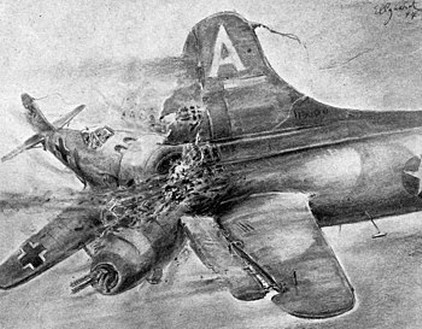
Fonte: Wikipedia
Il Ta 152 H-1, Numero di serie 150 168, pilotato da Reschke il 24 aprile 1945, catturato dagli inglesi
British-captured Ta 152 H-1,Werknummer 150 168, flown by Reschke on 24 April 1945
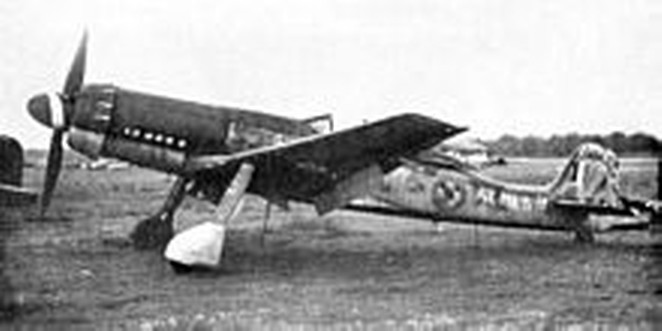
Fonte: Wikipedia
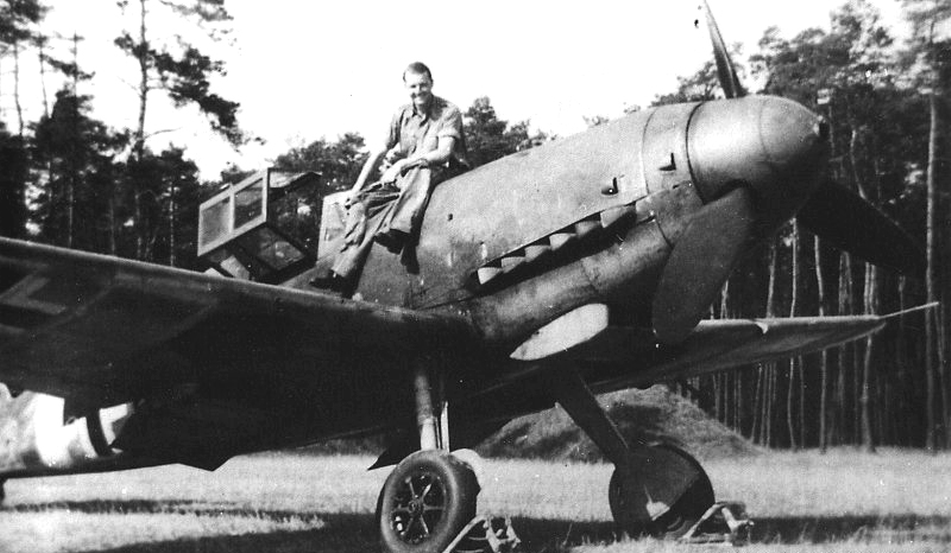
Il Maggiore Willi Reschke sul suo Bf 109G
Fonte: Flickr, GLORY. The largest archive of german WWII images
Home Page | Modellismo | Topolini | Altri Disney | Linus | Asterix | Diabolik | Giornalini di guerra | Western | Riviste | Romanzi | Mappa generale del sito
